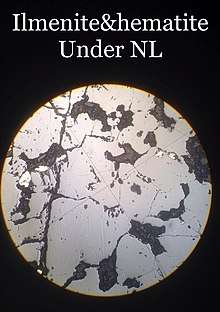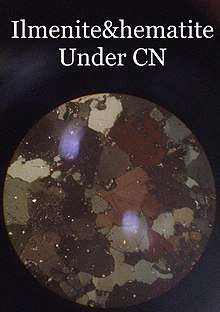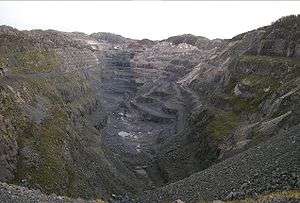Ilmenite
Ilmenite, also known as manaccanite, is a titanium-iron oxide mineral with the idealized formula FeTiO
3. It is a weakly magnetic black or steel-gray solid. From a commercial perspective, ilmenite is the most important ore of titanium.[4] Ilmenite is the main source of titanium dioxide, which is used in paints, printing inks[5], fabrics, plastics, paper, sunscreen, food and cosmetics.[6]
| Ilmenite | |
|---|---|
 Ilmenite from Miass, Ilmen Mts, Chelyabinsk Oblast', Southern Urals, Urals Region, Russia. 4.5 x 4.3 x 1.5 cm | |
| General | |
| Category | Oxide mineral |
| Formula (repeating unit) | iron titanium oxide, FeTiO 3 |
| Strunz classification | 4.CB.05 |
| Dana classification | 04.03.05.01 |
| Crystal system | Trigonal |
| Crystal class | Rhombohedral (3) H-M symbol: (3) |
| Space group | R3 |
| Unit cell | a = 5.08854(7) c = 14.0924(3) [Å]: Z = 6 |
| Identification | |
| Color | Iron-black; gray with a brownish tint in reflected light |
| Crystal habit | Granular to massive and lamellar exsolutions in hematite or magnetite |
| Twinning | {0001} simple, {1011} lamellar |
| Cleavage | absent; parting on {0001} and {1011} |
| Fracture | Conchoidal to subconchoidal |
| Tenacity | Brittle |
| Mohs scale hardness | 5–6 |
| Luster | Metallic to submetallic |
| Streak | Black |
| Diaphaneity | Opaque |
| Specific gravity | 4.70–4.79 |
| Optical properties | Uniaxial (–) |
| Birefringence | Strong; O = pinkish brown, E = dark brown (bireflectance) |
| Other characteristics | weakly magnetic |
| References | [1][2][3] |
Structure and properties
Ilmenite crystallizes in the trigonal system. The ilmenite crystal structure consists of an ordered derivative of the corundum structure; in corundum all cations are identical but in ilmenite Fe2+ and Ti4+ ions occupy alternating layers perpendicular to the trigonal c axis. Containing high spin ferrous centers, ilmenite is paramagnetic.
Ilmenite is commonly recognized in altered igneous rocks by the presence of a white alteration product, the pseudo-mineral leucoxene. Often ilmenites are rimmed with leucoxene, which allows ilmenite to be distinguished from magnetite and other iron-titanium oxides. The example shown in the image at right is typical of leucoxene-rimmed ilmenite.
In reflected light it may be distinguished from magnetite by more pronounced reflection pleochroism and a brown-pink tinge.
Samples of ilmenite exhibit a weak response to a hand magnet.
Discovery
In 1791 William Gregor discovered ilmenite, in a stream that runs through the valley just south of the village of Manaccan (Cornwall), and identified for the first time titanium as one of the constituents of ilmenite.[7]
Mineral chemistry



Ilmenite most often contains appreciable quantities of magnesium and manganese and the full chemical formula can be expressed as (Fe,Mg,Mn,Ti)O3. Ilmenite forms a solid solution with geikielite (MgTiO
3) and pyrophanite (MnTiO
3) which are magnesian and manganiferous end-members of the solid solution series.
Although there appears evidence of the complete range of mineral chemistries in the (Fe,Mg,Mn,Ti)O3 system naturally occurring on Earth, the vast bulk of ilmenites are restricted to close to the ideal FeTiO
3 composition, with minor mole percentages of Mn and Mg. A key exception is in the ilmenites of kimberlites where the mineral usually contains major amounts of geikielite molecules, and in some highly differentiated felsic rocks ilmenites may contain significant amounts of pyrophanite molecules.
At higher temperatures it has been demonstrated there is a complete solid solution between ilmenite and hematite. There is a miscibility gap at lower temperatures, resulting in a coexistence of these two minerals in rocks but no solid solution. This coexistence may result in exsolution lamellae in cooled ilmenites with more iron in the system than can be homogeneously accommodated in the crystal lattice.
Altered ilmenite forms the mineral leucoxene, an important source of titanium in heavy mineral sands ore deposits. Leucoxene is a typical component of altered gabbro and diorite and is generally indicative of ilmenite in the unaltered rock.
Paragenesis

Ilmenite is a common accessory mineral found in metamorphic and igneous rocks. It is found in large concentrations in layered intrusions where it forms as part of a cumulate layer within the silicate stratigraphy of the intrusion. Ilmenite generally occurs within the pyroxenitic portion of such intrusions (the 'pyroxene-in' level).
Magnesian ilmenite is indicative of kimberlitic paragenesis and forms part of the MARID association of minerals (mica-amphibole-rutile-ilmenite-diopside) assemblage of glimmerite xenoliths. Manganiferous ilmenite is found in granitic rocks and also in carbonatite intrusions where it may also contain anomalous niobium.
Many mafic igneous rocks contain grains of intergrown magnetite and ilmenite, formed by the oxidation of ulvospinel. Ilmenite also occurs as discrete grains, typically with some hematite in solid solution, and complete solid solution exists between the two minerals at temperatures above about 950 °C.
Titanium was identified for the first time by William Gregor in 1791 in ilmenite from the Manaccan valley in Cornwall, southwest England.
Ilmenite is named after the locality of its discovery in the Ilmensky Mountains, near Miass, Russia.
Processing and consumption
Most ilmenite is mined for titanium dioxide production.[8] In 2011, about 47% of the titanium dioxide produced worldwide were based on this material.[9] Ilmenite and/or titanium dioxide are used in the production of titanium metal.[10][11]
Titanium dioxide is most used as a white pigment and the major consuming industries for TiO2 pigments are paints and surface coatings, plastics, and paper and paperboard. Per capita consumption of TiO2 in China is about 1.1 kilograms per year, compared with 2.7 kilograms for Western Europe and the United States.[12]
| Feedstock | TiO 2 Content | Process |
|---|---|---|
| (%) | ||
| Ore | <55 | Sulfate |
| Ore | >55 | Chloride |
| Ore | <50 | Smelting (slag) |
| Synthetic rutile | 88-95 | Chloride |
| Chloride slag | 85-95 | Chloride |
| Sulfate slag | 80 | Sulfate |
Ilmenite can be converted into pigment grade titanium dioxide via either the sulfate process or the chloride process.
Ilmenite can also be improved and purified to rutile using the Becher process.
Ilmenite ores can also be converted to liquid iron and a titanium-rich slag using a smelting process.[14]
Ilmenite ore is used as a flux by steelmakers to line blast furnace hearth refractory.[15]
Ilmenite sand is also used as a sandblasting agent in the cleaning of diecasting dies.
Ilmenite can be used to produce ferrotitanium via an aluminothermic reduction.[16]
Feedstock production
| Year | 2011 | 2012-13 |
|---|---|---|
| Country | USGS | Projected |
| Australia | 1,300 | 247 |
| South Africa | 1,161 | 190 |
| Mozambique | 516 | 250 |
| Canada | 700 | |
| India | 574 | |
| China | 500 | |
| Vietnam | 490 | |
| Ukraine | 357 | |
| Senegal | - | 330 |
| Norway | 300 | |
| United States | 300 | |
| Madagascar | 288 | |
| Kenya | - | 246 |
| Sri Lanka | 62 | |
| Sierra Leone | 60 | |
| Brazil | 48 | |
| Other countries | 37 | |
| Total world | ~6,700 | ~1,250 |
Australia was the world's largest ilmenite ore producer in 2011, with about 1.3 million tonnes of production, followed by South Africa, Canada, Mozambique, India, China, Vietnam, Ukraine, Norway, Madagascar and United States.
Although most ilmenite is recovered from heavy mineral sands ore deposits, ilmenite can also be recovered from layered intrusive sources or "hard rock" titanium ore sources.
The top four ilmenite and rutile feedstock producers in 2010 were Rio Tinto Group, Iluka Resources, Exxaro and Kenmare Resources, which collectively accounted for more than 60% of world's supplies.[18]
The world's two largest open cast ilmenite mines are:
- The Tellnes mine located in Sokndal, Norway, and run by Titania AS (owned by Kronos Worldwide Inc.) with 0.55 Mtpa capacity and 57 Mt contained TiO
2 reserves. - The Rio Tinto Group's Lac Tio mine located near Havre Saint-Pierre, Quebec in Canada with a 3 Mtpa capacity and 52 Mt reserves.[19]
Major mineral sands based ilmenite mining operations include:
- Richards Bay Minerals in South Africa, majority-owned by the Rio Tinto Group.
- Kenmare Resources' Moma mine in Mozambique.
- Iluka Resources' mining operations in Australia including Murray Basin, Eneabba and Capel.
- The Kerala Minerals & Metals Ltd (KMML), Indian Rare Earths (IRE), VV Mineral mines in India.
- TiZir Ltd.'s Grande Cote mine in Senegal[20]
- QIT Madagascar Minerals mine, majority-owned by the Rio Tinto Group, which began production in 2009 and is expected to produce 0.75 Mtpa of ilmenite, potentially expanding to 2 Mtpa in future phases.
Attractive major potential ilmenite deposits include:
- The Karhujupukka magnetite-ilmenite deposit in Kolari, northern Finland with around 5 Mt reserves and ore containing about 6.2% titanium.
- The Balla Balla magnetite-iron-titanium-vanadium ore deposit in the Pilbara of Western Australia, which contains 456 million tonnes of cumulate ore horizon grading 45% Fe, 13.7% TiO
2 and 0.64% V
2O
5, one of the richest magnetite-ilmenite ore bodies in Australia[21] - The Coburn, WIM 50, Douglas, Pooncarie mineral sands deposits in Australia.
- The Magpie titano-magnetite (iron-titanium-vanadium-chrome) deposits in eastern Quebec of Canada with about 1 billion tonnes containing about 43% Fe, 12% TiO2, 0.4% V2O5, and 2.2% Cr2O3.
- The Longnose deposit in Northeast Minnesota is considered to be "the largest and richest ilmenite deposit in North America."[22]
Most ilmenite ore production from Canada, South Africa and Norway is destined for titaniferous slag application.
Lunar ilmenite
Ilmenite has been found in Moon rocks,[23] and is typically highly enriched in magnesium similar to the kimberlitic association. In 2005[24] NASA used the Hubble Space Telescope to locate potentially ilmenite-rich locations. This mineral could be essential to an eventual Moon base, as ilmenite would provide a source of iron and titanium for the building of structures and essential oxygen extraction.
References
- Webmineral data
- Mineral Handbook
- Ilmenite on Mindat.org
- Heinz Sibum, Volker Günther, Oskar Roidl, Fathi Habashi, Hans Uwe Wolf, "Titanium, Titanium Alloys, and Titanium Compounds" in Ullmann's Encyclopedia of Industrial Chemistry 2005, Wiley-VCH, Weinheim. doi:10.1002/14356007.a27_095
- "Sachtleben RDI-S" (PDF).
- "Products". Mineral Commodities Ltd. Retrieved 2016-08-08.
- Gregor, William (1791) "Beobachtungen und Versuche über den Menakanit, einen in Cornwall gefundenen magnetischen Sand" (Observations and experiments regarding menaccanite [i.e., ilmenite], a magnetic sand found in Cornwall), Chemische Annalen …, 1, pp. 40–54, 103–119.
- "Industry Fundamentals". Mineral Commodities Ltd. Retrieved 2016-08-08.
- Market Study Titanium Dioxide, published by Ceresana, February 2013
- Kroll, W (1940). "The production of ductile titanium". Transactions of the Electrochemical Society. 78: 35–47. doi:10.1149/1.3071290.
- Seki, Ichiro (2017). "Reduction of titanium dioxide to metallic titanium by nitridization and thermal decomposition". Materials Transactions. 58 (3): 361–366. doi:10.2320/matertrans.MK201601.
- "Titanium Dioxide Chemical Economics Handbook".
- Hayes 2011, p. 5.
- Pistorius, P.C. (Jan 2008), "Ilmenite smelting: the basics" (PDF), The Journal of the South African Institute of Mining and Metallurgy, 108
- "Rio Tinto, Fer et Titane - Products". Rio Tinto Group. Retrieved 19 Aug 2012.
- Gasik, Michael (editor) (2013). Handbook of Ferroalloys: Theory and Technology. London: Elsevier. p. 429. ISBN 978-0-08-097753-9.CS1 maint: extra text: authors list (link)
- USGS 2012 Survey, p. 174
- Hayes 2011, p. 3.
- "Lac Tio Mine". InfoMine. Retrieved 16 Aug 2012.
- "TiZir Limited". Mineral Deposits Limited. Archived from the original on 2012-08-18. Retrieved 16 Aug 2012.
- "Vanadium - AIMR 2011 - Australian Mines Atlas".
- Kraker, Dan. "Titanium Range? Breakthrough could lead to new kind of mining in NE Minn". Retrieved 2017-05-31.
- Bhanoo, Sindya N. (28 December 2015). "New Type of Rock Is Discovered on Moon". New York Times. Retrieved 29 December 2015.
- http://news.bbc.co.uk/1/hi/magazine/4177064.stm How to set up a moonbase. NASA
Sources
- Hayes, Tony (2011), Titanium Dioxide: A Shining Future Ahead (PDF), Euro Pacific Canada, p. 5, retrieved 16 Aug 2012